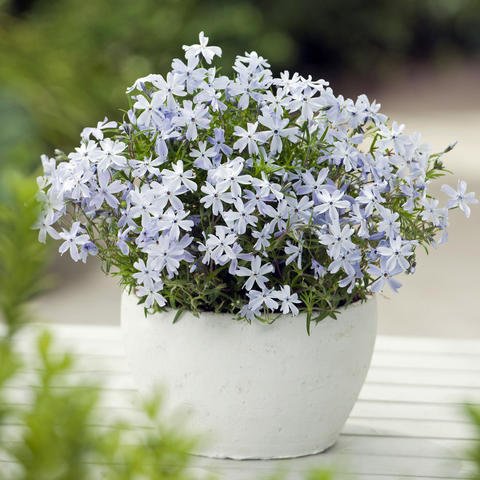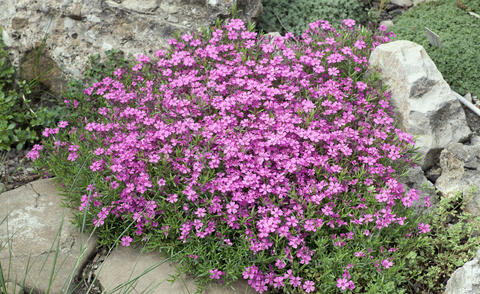Carpet phlox, cushion phlox
Carpet phlox delights us early on in the year with its dense carpet of flowers. The alpine perennial is a no-fuss and undemanding plant.
Factsheet
- Growth type
-
- Perennial plant
- Growth height (from)
- from 5 cm to 15 cm
- Growth width (from)
- from 20 cm to 30 cm
- Growth characteristics
-
- flat growing
- cushion-forming
- carpet forming
- foothills
- Flower color
-
- purple
- blue
- pink
- white
- multicolored
- Flowering time (month)
-
- April to June
- Flower shape
-
- corymbus grapes
- terminal
- Flower characteristics
-
- unfilled
- Leaf color
-
- green
- page format
-
- needle-shaped
- Sheet properties
-
- wintergreen
- Fruit characteristics
-
- unimpressive
- Light
-
- sunny
- semi-shade
- Soil type
-
- stony to sandy
- Soil Moisture
-
- dry to fresh
- ph value
-
- weakly alkaline to neutral
- Lime compatibility
-
- sensitive to lime
- Nutrient requirements
-
- moderately nutritious
- Humus
-
- low humus
- Decorative or utility value
-
- Flower Decoration
- Nectar or pollen plant
- Winter Hardness
-
- hardy
- areas of life
-
- FR1
- FR2
- Use
-
- Flowerbeds
- ground cover
- Borders
- Group planting
- Planters
- Dry stone walls
- Garden style
-
- cottage garden
- Flower garden
- Roof Garden
- Stone Garden
- Pot garden
- Bee Friendly
- bee friendly plant
The Carpet phlox or Cushion phlox (Phlox subulata) is one of the inferior varieties of the flame flowers (phlox) from the phlox family (Polemoniaceae). It originates from the northern United States, where it grows on the edges of forests and on wastelands with low levels of humus. Because of its early flowering, gardeners categorize Phlox subulata in the spring phloxes.
Carpet phlox is an easy to care for rock garden plant that grows like creepers and forms tufts of wonderful, carpet-like, sometimes overhanging flower cushions with colors ranging from white to dark red. The winter-hardy shrub spreads quickly and is anywhere between 1.96 inches to 5.90 inches tall. The fine roots of Phlox subulata can reach up to 23.62 inches into the ground.
Carpet phlox is wintergreen and has needle-shaped, green leaves. The small leaves form a thick carpet under the dynamic flowers.

Between April and June, Phlox subulata exhibits masses of star-shaped flowers, depending on the variety in white, light purple, pink, carmine red, purple red or light lavender blue. Nowadays, multicolored cultivated forms are available, many of them have a distinctive "eye" in the center of the flower. The flowers are terminal and about 0.98 inch in size. They attract a lot of bees.
Like all phlox species, the carpet phlox prefers full sun. The perennial also tolerates partial shade, but the lack of sun has a negative impact on the abundance of flowers.
The preferred soil of Phlox subulata should be dry to fresh, well-drained and should have only moderate quantities of nutrients. The substrate can be sandy and mineral. The Cushion phlox, on the other hand, does not tolerate very calcareous soil particularly well, and acidic soils are a complete no-no. The top soil thickness should not be less than 7.87 inches so that the roots latch on well. Waterlogging must be avoided at all costs.

To form a dense carpet of the Carpet phlox, it is necessary to plant around ten specimens for 10.76 square feet. When planting individually, there should be a distance of about 11.81 inches between the plants. Phlox subulata can also be combined as small tuffs or spread out individually over a dry stone wall. The best time to plant is in early spring, but pot perennials can be planted throughout the summer. Freshly planted Carpet phlox need to be watered regularly for it to grow well.
Annual pruning after flowering keeps the cushion phlox in shape, prevents infestation with nematodes and sometimes even triggers a second flowering. A brushwood cover provides mild protection from the winter sun. The Carpet phlox can easily survive with dry periods. As Phlox subulata has low nutrition demands, no separate fertilization is required.

Clusters that have become too large can be divided in late fall or in spring when budding begins. To do this, the entire perennial, including the root ball is plucked out from the soil by fingers and divided into smaller segments. These new segments are planted immediately. A regular division of the carpet phlox is not required as it might lead to plant ageing.
As groundcover Carpet phlox is particularly suitable for planting rock gardens, wall deck, as a bed border on terraces and paths, between slabs and stairs, in roof gardens, in wall joints and for dry stone walls. The small flowers go well with rock speedwell (Veronica prostrata), alyssum and evergreen Candytuft (Iberis sempervirens), but also when accompanied with bulb flowers or other gardencovers such as Blue cushions (Aubrieta) or Cushion bellflower (Campanula). As an understory plant below trees or lush waves of flowers in containers and troughs. In this case, provide sufficient drainage either in the form of gravel, sand or expanded clay. Even for flower beds the discreet, at the same time colorful, Cushion phlox are preferred.

A well-known variety is Phlox subulata “Dwarf Carpet”. Its dark pink flowers with reddish eyes give a romantic touch to the garden. Its rich colors are refreshing to see in spring. “Maischnee” is a pure white variety, “Bavaria” has a blue-violet eye inside the white flower. “Candy Stripes” and “Kimono” have white flowers with pink stripes and dark eyes. The large flowers of “Mc Daniel’s Cushion” glisten in a deep dark pink. “Purple Beauty”, a dark purple variety, for those who prefer darker colors. Phlox subulata “Temiscaming” appears in bright dark pink, which turns any dull garden corner into a show stage. A particularly robust variety is the “Emerald Cushion Blue”, which is well suited for planting in large areas. A hardy plant, its blossoms are of a delicate purple color.

Carpet phlox is propagated either by division or by cuttings. Young shoots without flower buds are used for cuttings. The Carpet phlox also spreads quickly through root runners, so propagation by division is the simpler option.
Phlox subulata is sometimes attacked by stem nematodes. Withering stems and leaves are a sign of infestation by this pest. Pruning the plant up to the ground is necessary in such cases. Downy mildew and powdery mildew commonly infect all phlox varieties. As a protective measure, the plants should not dry out and watering over the leaves should be avoided. Infested parts of the plant should be removed if the infestation is severe and the remaining shrub should be treated with a fungicide.

